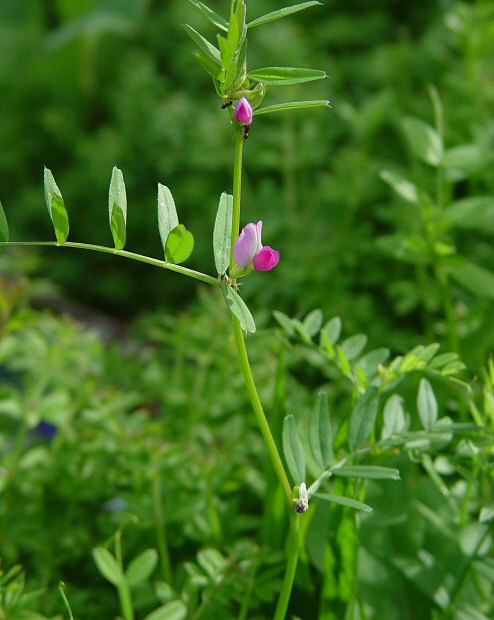Vicia sativa L.
Narrow-Leaved Common Vetch

Introduced
CC = *
CW = 3
MOC = 34
© SRTurner
Vicia sativa L.Narrow-Leaved Common Vetch | |
 |
Introduced CC = * CW = 3 MOC = 34 |
© SRTurner |
|
Family - Fabaceae/Faboideae Habit - Taprooted annual forb. Stems - Ascending to weakly erect or trailing and climbing, sparsely and finely hairy to glabrous or nearly so, to 1 m, winged from decurrent leaf (stipule) tissue, hollow. Leaves - Alternate, stipulate, even-pinnate with 8-16 leaflets. Petioles 1-3 mm long, the tendrils branched. Stipules 4-6 mm long, sometimes with a prominent, purplish brown, glandular spot on the undersurface, mostly sharply several-lobed and/or toothed. Leaflets 15-28 mm long, 2-7 mm wide, those of the lower leaves often shorter and broader than those of the upper leaves, linear to oblanceolate, those of the lower leaves sometimes obovate, tapered at the base, rounded to truncate or notched at the tip, the midvein extended as a minute, sharp point at the very tip, the surfaces glabrous or especially the undersurface sparsely and finely hairy.
Inflorescence - Sessile, of one or two flowers from leaf axils, each with a stalk 1-2 mm long.
Flowers - Calyces glabrous or finely hairy along the nerves and lobe margins, the tube 4-5 mm long, the base oblique but not or only slightly pouched, the attachment appearing basal but somewhat off-center, the lobes 3-5 mm long, subequal (the lowermost only slightly longer than the other lobes), narrowly triangular. Corollas papilionaceous, 12-18 mm long, pinkish purple to purplish blue, the banner only slightly curved upward, strongly curved around the wings and keel. Stamens with the fused portion 7-8 mm long, the free portion 1-2 mm long. Style short, 1.1 mm long, encircled by a conspicuous band of dense hairs toward the tip.
Fruits - Legumes 25-50 mm long, 3-6 mm wide, sessile, minutely hairy when young, becoming sparsely hairy or glabrous at maturity, dark brown to black at maturity, 4-12-seeded. Seeds 2.5-3.0 mm long, dark brown and mottled with black to solid black, circular to bluntly oblong in outline, not flattened, the attachment scar not raised, white, extending only about 1/4 the circumference of the seed.
Flowering - April - July. Habitat - Forest openings, streambanks, tops of bluffs, pastures, fencerows, fields, gardens, railroads, roadsides and open disturbed areas. Origin - Native to Europe. Lookalikes - None when flowering. Vegetatively resembles other species of Vicia, and also Lathyrus spp. Other info. - This small legume is found in numerous scattered locations in Missouri, predominantly in the southern half of the state. It is common in much of the southeastern quadrant of the continental U.S. and New England, with scattered locations elsewhere in the country. It is easily recognized by its pinnate leaves with terminal branched tendrils, and axillary inflorescences of paired flowers. Another distinctive feature is the dark glandular spots on the star-shaped stipules, though this is sometimes absent. Currently, ssp. nigra is recognized as being distributed within the state. The ssp. sativa, which is somewhat less weedy with larger flowers and fewer leaflets, is found in most states bordering Missouri and thus is expected to appear in Missouri at some point. Photographs taken in Gainesville, FL., 2-14-03, and in Notasulga, AL., 11-18-04 (DETenaglia); also at Weldon Spring Conservation Area, St. Charles County, MO, 5-4-2008, near Treloar, Warren County, MO, 5-13-2013, Klondike County Park, St. Charles County, MO, 5-29-2017, along the Katy Trail near Dutzow, Warren County, MO, 4-20-2020, Sand Prairie Conservation Area, Scott County, MO, 5-22-2022, and on Riverfront Park, Washington, Franklin County, MO, 4-24-2025 (SRTurner). |